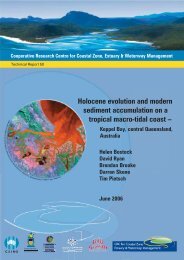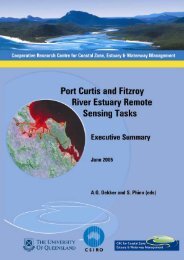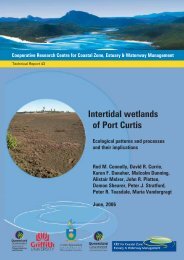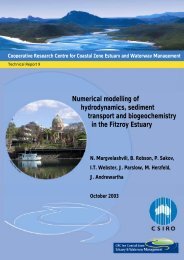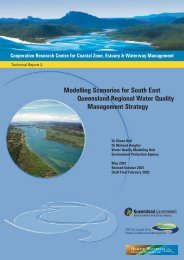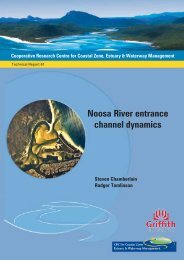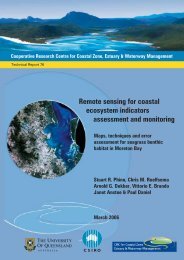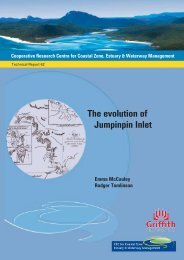Contaminant pathways in Port Curtis: Final report - OzCoasts
Contaminant pathways in Port Curtis: Final report - OzCoasts
Contaminant pathways in Port Curtis: Final report - OzCoasts
You also want an ePaper? Increase the reach of your titles
YUMPU automatically turns print PDFs into web optimized ePapers that Google loves.
<strong>Contam<strong>in</strong>ant</strong> <strong>pathways</strong> <strong>in</strong> <strong>Port</strong> <strong>Curtis</strong>: F<strong>in</strong>al <strong>report</strong>7: Antioxidant enzymes as biomarkersChapter 7 Antioxidant enzymes as biomarkers ofenvironmental stress <strong>in</strong> oysters <strong>in</strong> <strong>Port</strong> <strong>Curtis</strong>7.1 IntroductionThe screen<strong>in</strong>g level risk assessment of contam<strong>in</strong>ants <strong>in</strong> <strong>Port</strong> <strong>Curtis</strong> (Apte et al.2005) found that concentrations of metals <strong>in</strong> sediments and dissolved metals <strong>in</strong>the waters were generally below levels of regulatory concern. However,concentrations of a variety of metals were significantly enriched <strong>in</strong> mar<strong>in</strong>e biota <strong>in</strong>comparison with organisms sampled at reference sites. Studies prior to this hadalso flagged concentrations of some metals, <strong>in</strong> particular, copper and z<strong>in</strong>c <strong>in</strong> mudcrabs (Andersen & Norton 2001) and copper <strong>in</strong> seagrass (Prange 1999) andfiddler crabs (Andersen et al. 2002), as potentially anomalous <strong>in</strong> <strong>Port</strong> <strong>Curtis</strong>relative to background levels. The demonstration of bioaccumulation of acontam<strong>in</strong>ant, however, does not necessarily mean that organisms will displayadverse effects. There is a need to demonstrate a l<strong>in</strong>k between exposure and anadverse biological response.Biomarkers are biochemical, physiological or histological changes that measuresublethal effects of, or exposure to, toxic chemicals (Weeks 1995; Luebke et al.1997), and generally but not exclusively perta<strong>in</strong> to a response at a specific organ,cellular or subcellular level of organisation (O'Halloran et al. 1998). These cellularand molecular responses can be used as early warn<strong>in</strong>g signals of environmentalstress, before whole organism effects become apparent (Regoli et al. 1998).Environmental pollutants generally cause an <strong>in</strong>crease <strong>in</strong> peroxidative processeswith<strong>in</strong> cells, caus<strong>in</strong>g oxidative stress (W<strong>in</strong>ston & Giulio 1991; Cheung et al. 2001;Nusetti et al. 2001). Lipid peroxidation (LPO) has often been used as a biomarkerof environmental stress, reflect<strong>in</strong>g damage to cell membranes from free radicals(R<strong>in</strong>gwood et al. 1999). The extent of damage caused by oxyradical production isdependent on antioxidant defences, which <strong>in</strong>clude antioxidant enzymes and freeradical scavengers, such as glutathione (Doyotte et al. 1997). Therefore,antioxidant enzymes are some of the most common biomarkers used <strong>in</strong>environmental monitor<strong>in</strong>g (Regoli et al. 1998).The enzymes usually respond rapidly and sensitively to biologically activepollutants (Fitzpatrick et al. 1997). Some of the most commonly used antioxidantenzyme biomarkers <strong>in</strong>clude catalase (CAT) and glutathione-s-transferase (GST)(W<strong>in</strong>ston & Giulio 1991; Regoli & Pr<strong>in</strong>cipato 1995; Regoli et al. 1998). Glutathione(GSH) is often used <strong>in</strong> biomarker studies, as it is an overall modulator of cellular80





